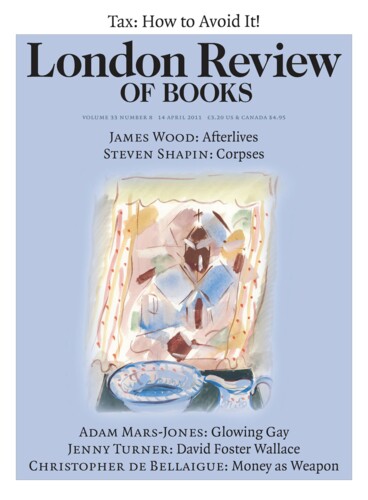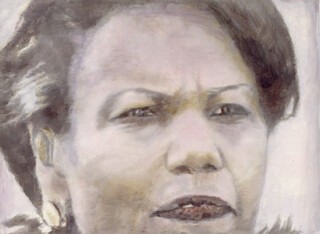Luc Tuymans’s painting Altar (2002) depicts a wedding chapel in a Mormon temple. It’s a space that only church members are allowed to enter, so – as Ralph Rugoff recounts in the catalogue to the retrospective of the Belgian painter’s work at Bozar, the Palais des Beaux-Arts in Brussels (until 8 May) – Tuymans based the painting on a photograph taken by a surveillance camera.*The process, Rugoff explains, is one of ‘translating this covert picture of a closed, members only area.’
That sounds familiar. Commentaries on contemporary art often read, even to art critics, like they’re providing a key to covert pictures of a closed, members only area and that’s particularly the case with Tuymans, analysis of whose work tends to be based less on the paintings themselves than on their iconography as revealed through their photographic sources. Maybe that’s unavoidable, a function of the allegorical structure of the works themselves: that is, of the breach between the seemingly uncommunicative surface of the image and the textual accompaniment it seems to demand. This structure is hardly unique to Tuymans’s work – it’s been more than 30 years since Craig Owens proposed it as typical of postmodernism – but his way of articulating it has made him one of the most influential painters of the last two decades.
Altar is not among the 75 paintings on view at Bozar, but the dissociation between what anyone can discern of its subject matter just by looking at it and what one can find out about it is typical of Tuymans’s paintings. One striking example is Wrapping Paper (1991). Before reading the title, you’d be inclined to see it as an abstract painting – a sequence of rather muted pink horizontal stripes on a white ground, painted in something like the drained, diffident manner of the Belgian painter Raoul de Keyser, whom Tuymans is known to admire. The title tells us that this is not exactly an abstraction and adds a fresh layer of irony to the painting: wrapping paper means presents, fun, celebration, but Tuymans has rendered it glum, worn out. But there’s more, because in an extensive commentary on some of his paintings from 1991 – introduced with the warning that ‘the small gap between the explanation of a picture and a picture itself provides the only possible perspective on painting,’ and tellingly titled ‘Disenchantment’ – Tuymans has explained that the source for this image was wrapping paper from the DDR, which had been dissolved the previous year. So if we want we can take this as a history painting; and for anyone who happened to spend a day on the other side of Checkpoint Charlie in the latter days of East Germany, the painting’s aroma of ‘something that has come to an end and goes no further’, as Tuymans puts it, seems entirely authentic.
Tuymans’s early paintings take their imagery from various sources – found photographs or reproductions or his own notations, or, in this case, an objet trouvé – but soon after Wrapping Paper, Tuymans began working almost exclusively from photographs, systematically deriving from their use what might be called, after his 1992 series Der Diagnostische Blick, a diagnostic view of things based on detachment rather than empathy. But the detachment is also between the painting and its photographic source, that is, between the painting and the explanation that discloses the source. The painting’s title not only sums up the cold-eyed, disenchanted way of looking at things that Tuymans had long been cultivating; it is the title of the medical manual on whose illustrations the paintings were based. What happens, Tuymans seems to be asking, when this clinical gaze is incorporated into painting? The distinctly harsh, unsensual way he depicts a pair of legs in Der Diagnostische BlickVIII, or a single cancerous breast in VII – coarse drawing, brackish hues – tells you in an instant that such paintings have nothing to do with the classical idealisation of the human form, yet just as little with the pathos and protest of expressionism. But Tuymans’s rough, nervous paint handling effectively erases the distinction between, say, the eczema that the photograph used for VIII was meant to show and normal skin. It all looks vaguely unhealthy: the infirmity is metaphysical.
Tuymans takes the clinician’s suspicious gaze as a model but turns it against itself. ‘The sickness is in the spectator,’ he has said of Der Diagnostische Blick, only to contradict himself with the idea that, rather, ‘sickness should appear in the way the painting is made.’ In any case, the fact that the photographs on which the paintings were based were taken for medical purposes comes to seem like a red herring. Tuymans could paint almost anything and make it evince disquiet. It really is there in the way the paintings are made: in the sombre, greyed-out palette, as if he’d used old-fashioned atmospheric perspective to push everything into the distance, leaving no foreground; in the way that objects and people seem to be so firmly placed in the pictorial field that they are slightly constrained by it; above all, perhaps, in the tense, dogged way the paint is laid down – those abrasive, determined little strokes make me think of a man trying to dig his way out of prison with a spoon.
‘Tuymans has consistently taken on the world-defining and life-shattering events of the last century,’ Helen Molesworth writes in her catalogue essay, citing ‘the Holocaust, colonialism, nationalism, and most recently, the events and aftermath of 9/11’. What she says is true, as long as ‘taken on’ means ‘worked from photographic imagery derived from’. But can it really mean that? A 1997 painting of an inept skier fallen on his behind turns out to be taken from a home movie of Albert Speer. Does it really matter that it’s Speer? Tuymans ‘takes on’ those weighty historical topics precisely by observing the way painting detaches itself from them, and the feeling of regret over this visible disengagement is part of the paintings’ subject. It’s tempting to turn Tuymans’s aesthetic of suspicion back on itself and accuse these paintings of wanting to have it both ways. More and more, though, as time goes on, Tuymans seems willing to let his imagery keep its own counsel; the blanched, luminous Carpet (2003) is eerie enough as it is, with no need for the nudge that would have come from learning that it was a carpet belonging to, say, a prominent Nazi or one of the assassins of Patrice Lumumba (the subject of a cycle of paintings Tuymans presented at the 2001 Venice Biennale).
Just occasionally, Tuymans treats his source material in a less oblique way. Someday people will need to be told that the tetchy, tight-mouthed face in The Secretary of State (2005) is that of Condoleezza Rice – but that time is still to come. What’s clear, though, is that her ‘No comment’ is echoed in the painting. Not only is he not editorialising – the catalogue’s critique of her public persona does little to illuminate the painting – but her wary squint towards some indeterminate future somewhere off to the painting’s right might be one that Tuymans recognised as rhyming with his own chilly viewpoint, and with the ‘cold and ungenerous gaze on reality’ that he admires in Jan Van Eyck.
But then we might doubt that Van Eyck is really as niggardly as Tuymans says. He likes to play the tough guy, and he’s built for the role – he’s even supposed to have worked as a bouncer as a young man. He disclaims any aestheticism, yet much of his delicately inflected near monochromy would do Whistler proud, and Rothko might have liked these paintings’ dull, smouldering glow. There’s something grand and expansive in Tuymans’s art that isn’t accounted for by its relation to its subject matter. To show paintings that evoked the Nazi era in his first show in Berlin, or Belgian colonialism in Venice, or the Bush administration in a New York show at the beginning of Bush’s second term may reflect his need to discomfit – but that’s just to soften you up for what’s going to hit you between the eyes.
Send Letters To:
The Editor
London Review of Books,
28 Little Russell Street
London, WC1A 2HN
letters@lrb.co.uk
Please include name, address, and a telephone number.


